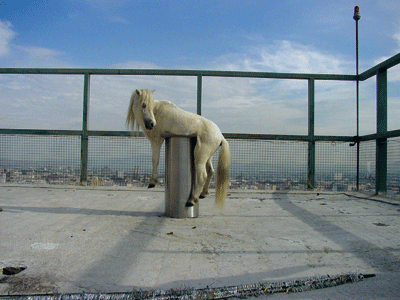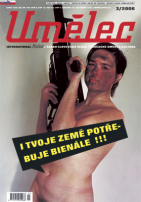| Revista Umělec 2006/3 >> TIRANA PRISHTINA PROJECT 2005 | Lista de todas las ediciones | ||||||||||||
|
|||||||||||||
TIRANA PRISHTINA PROJECT 2005Revista Umělec 2006/301.03.2006 Feni Zguro | info | en cs de |
|||||||||||||
|
Travelling to Prishtina for participation in an exhibition, by plane, takes just 25 minutes. In this way, one escapes the 2000 hooks of Kukës ‘highway’ and the, not so nice to experience, human landscape. Getting back to our example, the artist finds the inspiration and presents a project inbetween Albania and Kosovo. This was the idea of Florian Agalliu, coordinator and organiser of art events. He decided to realise it through a cycle of video reports.
At this point, I decided to create a project with the same title, but with no connection to the video report, with the participation of several Albanian and foreign artists. Therefore the project TiranaPrishtina (the one of mine) aimed to create a retrospective on the work of the Albanian artists from the mid 1990s; a time when Edi Rama (today Mayor of Tirana) started for the first time to create a structure in which the students of the Academy of Arts in Tirana could get familiar with visual arts. This approach was of great importance for young artists such as Anri Sala, Adrian Paci, Alban Hajdinaj and Gentian Shkurti etc. Simultaneously, TiranaPrishtina wanted to build up collaboration between very young and yet unknown artists in Albania, and monitor the art exhibitions through the Albanian media and different workshops. This project became a tool of information to help the audience of a city like Tirana, which still suffers the so-called hermetic system of communication. Even with the difficulties one can face in Albania when realising such initiatives, which are often determined as a lack of demureness and hooliganism, this project managed to finish, and energetically affect the paralysed cultural life of Albania, which has been abused by the fundamental market culture. 3 out of the 11 projects are discussed here: TIRANA OVERGROUND The project Tirana Overground intended to integrate a wide audience in the structure of visual art. The aim of this project was to take the artist out of typical exhibiting institutions, to make their work in urban spaces from bars to bus stops. The art went where the public is and not vice versa. In a country like Albania, visual art is completely unknown and the only way to familiarise it with the audience and the public is to have it in the streets, where social problems exist for real. One exhibition overtly achieved the objectives of Tirana Overground. Armand Lulaj, Ergin Zaloshnja, Arian Risvani, Heldi Pema, Andi Belalla and Fani Zguro together made an artistic intervention at Koman’s Hydro Central. This object is one of the most ambitious projects of the ‘5 year plan’ of the ex-socialist system in Albania. This hydro central, which supplied the whole country with electric energy, nowadays is not a farseeing project but an inoperative ecological catastrophe. Inspired by this contradictory situation, as randomly happens in Albania, Armando Lulaj realised in the embouchure of Koman’s hydro central an enormous star, which at the end of the executive process took fire and converts to ‘nothing’. Ergin Zaloshnja improvised a virtual cemetery with five graves, onto which he wrote the initials of some of the best known Albanian artists. The story continues with the performance of Arian Risvani, where a group of narcissists discuss nationalistic themes and their current situation. In parallel to this Andy Belalla organizes another performance: a football match of two teams that suffer unification of their shirts – the one of Maradona. Here the artist plays with the Albanian mentality of everyone feeling number one. OPEN SPACE Nowadays few people try to bring new dimensions to their professions. In the developing countries this is not seen as the basic condition of development but as lies for the books of history. Let us imagine a deserted island, such as ‘Sazan,’ where there exists only a military command that gets even the water from somewhere else. From this hermetic ambient, was conceptualised the the project Open Space. The project consists of presenting a Kino-Forum, where some of the innovating personalities of contemporary art would be introduced in a military command through documentaries and conferences. Artists, curators, musicians and film makers such as Harald Szeemann, J.T.Leroy, Mike Patton and Kitano Takeshi were the ones who brought the new space, in a place where the only space was the Ionian Sea. The first contact with the military was quite chaotic. Afterwards they started to familiarise with a platform that had nothing to do with discipline and military courage, but with what the art offers when it gets out of the formal frame of photocopy and traces new spaces in order to bring it in the most experimental form of research. DAMMI I COLORI Dammi i Colori is a video documentary made by the Albanian artist Anri Sala in collaboration with Mayor Edi Rama for the penultimate edition of the Venice Biennale. This documentary touches on the basic changes that have happened in Tirana after the coming to power of Rama, the new mayor. After this documentary was made the artists Alban Hajdinaj, Gentian Shkurti, Heldi Pema and Fani Zguro each filmed a short video based on this theme, presenting different transformations of Tirana. Their videos Eye to Eye, Colour Blind in Tirana, Client and Torture Stamp are visions against the backdrop of a ‘new’ city, inherant with the ‘old’ problems of Albanian society. A sole juridicial force like Edi Rama is not enough for radical change. Despite his initiatives, Tirana suffers from corruption within the state apparatus, the incriminated mentality of the society and miserable poverty. The videos of Dammi i Colori deal precisely with these dilemmas, and besides the Gallery of Arts in Tirana were presented at the “EXIT” festival in Novisad. In order that these problems be released from the situation that creates them, and take another form on the visual screen, these five videos were presented next to the performances of Fat Boy Slim, Underworld and White Strike. The project Dammi i Colori presents, simultaneously, two Albanian personalities such as Edi Rama and Anri Sala as metaphors of an effort for change in a town where change is measured by exchange rates and every synonym of this change, related to art, is seen as a time consuming investigation. We find this inconvenience in the videos made by th e participating artists.
01.03.2006
Artículos recomendados
|
|||||||||||||










Comentarios
Actualmente no hay comentariosAgregar nuevo comentario